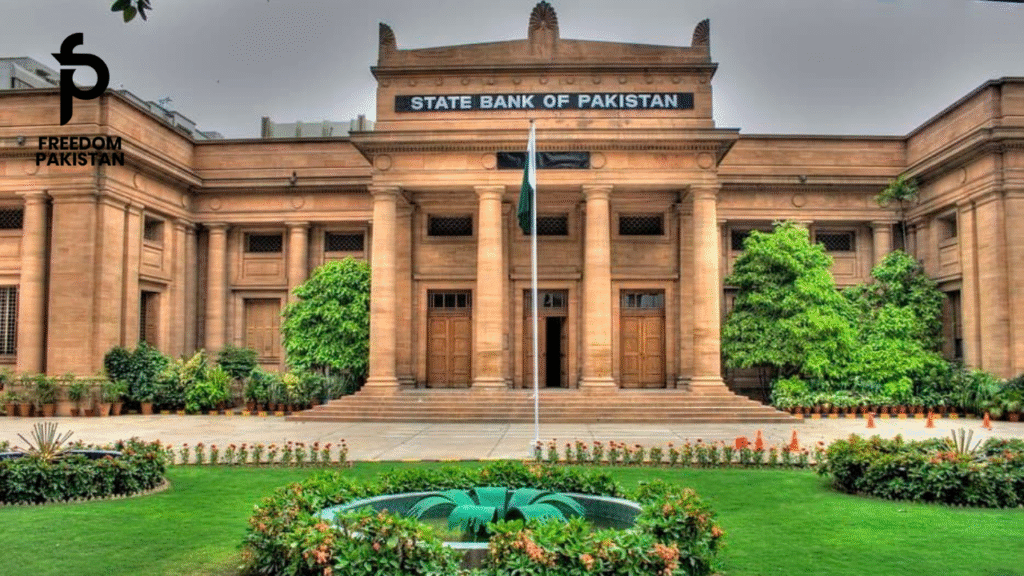The State Bank of Pakistan (SBP) is projecting a profit of Rs. 2.4 trillion for the fiscal year 2025 (FY25), aligning with the government’s broader fiscal objectives and the country’s economic targets. This forecast comes in the wake of the bank’s record-breaking profit of Rs. 3.42 trillion in FY24, making it one of the key financial institutions in Pakistan driving the national economy. The SBP’s forecast for FY25, though slightly lower than the previous year, holds substantial significance not just for the institution itself, but for the broader economic landscape of Pakistan.
Overview of SBP’s Profit Forecast for FY25
The State Bank of Pakistan, as the central bank, plays a critical role in the management of the country’s monetary policy and financial health. A forecasted profit of Rs. 2.4 trillion for FY25 reflects both the State Bank of Pakistan’s continued financial strength and the challenging economic conditions that the country faces in the coming year. This projection aligns with the targets set by the government, which hopes to manage inflation and other economic variables effectively.
This profit figure is lower than the previous year’s Rs. 3.42 trillion, which was considered a remarkable achievement and a sign of resilience despite tough external conditions. The decline in forecasted profit is attributed to a variety of factors, including inflationary pressures, regional geopolitical tensions, and global economic uncertainties. These elements continue to exert influence over Pakistan’s economy and have led the central bank to adjust its expectations for FY25.
Despite this adjustment, the projected Rs. 2.4 trillion remains a significant achievement, reflecting State Bank of Pakistan’s solid financial management and its vital role in steering Pakistan’s fiscal policies. The adjusted profit also signifies the broader health of the banking sector in Pakistan, which has performed relatively well under tough economic conditions.
Economic Implications of SBP’s Profit Forecast
The State Bank of Pakistan’s profit forecasts are not merely financial numbers—they have a direct impact on the country’s broader economic stability and government fiscal policies. The central bank’s profit directly contributes to government coffers, which can be used for a variety of national objectives, such as reducing public debt, funding infrastructure projects, and managing fiscal deficits.
In the case of Pakistan, where economic growth has been sluggish and inflationary pressures persist, the SBP’s profit plays an essential role in stabilizing the economy. The Rs. 2.4 trillion forecast suggests that while growth may be slower, the financial health of the central bank remains robust enough to contribute significantly to national finances.
The central bank’s forecast also offers insights into the country’s broader fiscal outlook. Pakistan’s ability to generate revenue through its banking and monetary systems is a key driver of the national budget. SBP’s role in managing foreign reserves, controlling inflation, and maintaining currency stability is critical in managing external debt, which remains a major concern for the country.
Furthermore, the State Bank of Pakistan’s profit forecasts reflect the bank’s ability to execute its monetary policy effectively, ensuring price stability, supporting economic growth, and stabilizing the exchange rate. These outcomes are essential to attracting investment and sustaining economic momentum.
SBP’s Transfer of Profits
As part of its operational mandate, the State Bank of Pakistan transfers its profits to the federal government after completing its annual audit. According to the forecast, the central bank is expected to transfer profits from FY25 after the audit approval, with the process occurring in FY26.
This transfer has a direct impact on the government’s budgetary process. With the transfer of profits, the government gains access to much-needed revenue, which can be used to finance development projects, reduce the budget deficit, or service external debt obligations. For Pakistan, a country grappling with a significant fiscal deficit, the State Bank’s profits are a key element of financial stability.
These profit transfers are critical, especially in a time when Pakistan is striving to balance its economic development goals with fiscal discipline. The government’s ability to use the State Bank’s transferred funds efficiently can go a long way in ensuring that the country’s economic growth remains on track despite global and regional challenges.
Economic Conditions Influencing SBP’s Profit Outlook
Several macroeconomic factors are contributing to the State Bank’s profit outlook for FY25. One of the most significant challenges is inflation, which remains a persistent issue for Pakistan. Inflationary pressures have been exacerbated by a combination of factors, including supply chain disruptions, rising commodity prices, and global market volatility. These factors have made it difficult for Pakistan to maintain a stable cost structure, which directly impacts consumer spending, business operations, and economic growth.
The SBP’s cautious profit forecast takes into account these inflationary pressures. The central bank is expected to continue using monetary tools, such as interest rate adjustments, to control inflation. As inflation rises, the State Bank may decide to maintain its policy rate at higher levels to curb inflation and stabilize the economy.
Additionally, regional geopolitical tensions—particularly those involving Pakistan’s neighbors—continue to pose a risk to Pakistan’s economic outlook. Trade disruptions, political instability, and border tensions can all create uncertainty in the economy, further complicating the State Bank’s ability to forecast profits. While Pakistan’s economic fundamentals remain resilient, geopolitical risks are outside the central bank’s control and can significantly affect its financial forecasts.
The State Bank also faces challenges in maintaining the stability of the Pakistani rupee. Currency volatility has been a persistent issue, which can influence inflation, import costs, and the overall purchasing power of Pakistani consumers. However, the SBP has managed to stabilize the currency to some extent through market interventions and its control over monetary policy.
World’s Safest Airlines of 2025 Revealed
You Can Also Read This
Policy Rate and Inflation
The State Bank’s decision to keep the policy rate at 11% for the time being is closely linked to its ongoing efforts to control inflation. The policy rate is one of the most important tools available to the central bank to manage inflation and stimulate or slow down economic activity. By adjusting interest rates, the SBP can influence the cost of borrowing, investment patterns, and consumer spending.
Given the current inflationary environment in Pakistan, maintaining the policy rate at 11% is a prudent move. Higher interest rates can help reduce inflation by making borrowing more expensive, thereby reducing spending and curbing demand-pull inflation. However, there is a delicate balance to be struck, as excessively high interest rates can dampen economic growth by discouraging investment and consumption.
In the coming months, the State Bank may reassess its policy rate depending on the inflation trajectory and other economic factors. It is likely that the central bank will take a cautious approach, considering both inflation control and the need for economic growth. Maintaining price stability is critical for ensuring long-term sustainable growth, especially as Pakistan navigates a challenging global economic environment.
Growth Drivers in Industry and Services
Despite these challenges, certain sectors in Pakistan are expected to show growth in FY25. The industrial sector, in particular, is expected to benefit from government stimulus measures and the recovery of the automotive sector. The auto industry, after facing a downturn in previous years, is now seeing signs of recovery. The government’s focus on industrialization, particularly in manufacturing and textiles, is expected to provide a boost to the economy.
The services sector is also expected to contribute to growth, especially in areas like financial services, information technology, and healthcare. This growth is supported by imports and positive economic indicators, such as a rising Purchasing Managers’ Index (PMI), which suggests that business sentiment is improving.
As the global economy recovers from the pandemic, Pakistan’s industrial and services sectors are well-positioned to capitalize on emerging opportunities. The growth in these sectors will help support overall GDP growth, despite external challenges.
Remittances and External Financial Outlook
Another bright spot in Pakistan’s economic outlook is the steady flow of remittances, which are projected to reach $38 billion in FY25. As the global diaspora expands and formal remittance channels become more efficient, Pakistan stands to benefit significantly from these inflows. Remittances play a vital role in supporting domestic consumption, stabilizing foreign exchange reserves, and reducing the current account deficit.
The expansion of formal remittance channels is particularly important in improving the transparency and reliability of these financial flows. The SBP has worked to encourage remittance inflows through initiatives such as the Roshan Digital Accounts, which have made it easier for Pakistanis living abroad to send money back home.
In terms of external financial management, Pakistan has largely settled its external repayments for FY25. The country’s foreign reserves are expected to reach a target of $14 billion, which will help the country weather any external shocks. With these reserves in place, Pakistan will have a stronger financial foundation to support its economic growth and meet its international obligations.
Challenges and Risks
Despite these positive indicators, Pakistan faces several risks that could affect the SBP’s forecast for FY25. Political instability, both domestically and regionally, remains a constant concern. Changes in government policies, challenges to governance, and social unrest can all create uncertainties that hinder economic progress.
The ongoing global economic slowdown and fluctuations in commodity prices also pose risks to Pakistan’s economic stability. While the country’s key sectors show signs of growth, global market fluctuations could dampen those prospects.
Additionally, while SBP’s forecast is optimistic, external debt and rising fiscal deficits continue to be significant risks. The management of public debt will be crucial for maintaining financial stability and ensuring that the economy remains on a growth trajectory.
Conclusion
In conclusion, the SBP’s forecast of Rs. 2.4 trillion profit for FY25 reflects both the challenges and resilience of Pakistan’s economic landscape. Despite inflationary pressures, regional tensions, and global economic volatility, the central bank remains a key pillar of stability for the nation. As Pakistan navigates a complex economic environment, the SBP’s policies, including its cautious approach to interest rates and its role in stabilizing the financial system, will be critical in ensuring the country’s continued growth and financial health.
While challenges remain, Pakistan’s economic fundamentals, including strong remittance flows, a recovering industrial sector, and growing external reserves, provide a solid foundation for the years ahead. The SBP’s proactive role in managing the country’s monetary policy and financial health will be pivotal in achieving the fiscal goals set for FY25 and beyond.




